
Sunbirds and spiderhunters make up the family Nectariniidae of passerine birds. They are small, slender passerines from the Old World, usually with downward-curved bills. Many are brightly coloured, often with iridescent feathers, particularly in the males. Many species also have especially long tail feathers. Their range extends through most of Africa to the Middle East, South Asia, South-east Asia and southern China, to Indonesia, New Guinea and northern Australia. Species diversity is highest in equatorial regions.
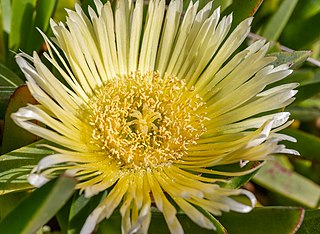
Carpobrotus edulis is a ground-creeping plant with succulent leaves in the genus Carpobrotus, native to South Africa. Its common names include hottentot-fig, sour fig, ice plant or highway ice plant.

The Aizoaceae, or fig-marigold family, is a large family of dicotyledonous flowering plants containing 135 genera and about 1800 species. They are commonly known as ice plants or carpet weeds. They are often called vygies in South Africa and New Zealand. Highly succulent species that resemble stones are sometimes called mesembs.

Tetragonia is a genus of about 85 species of flowering plants in the family Aizoaceae, native to temperate and subtropical regions mostly of the Southern Hemisphere, in New Zealand, Australia, southern Africa and South America.

Carpobrotus acinaciformis is a succulent perennial of the family Aizoaceae, native to South Africa.

Tetragonia tetragonioides, commonly called New Zealand spinach, Warrigal greens and other local names, is a flowering plant in the fig-marigold family (Aizoaceae). It is often cultivated as a leafy vegetable.
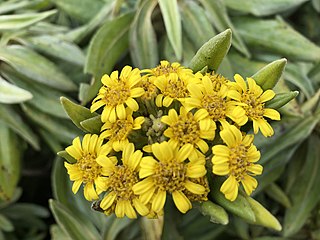
Brachyglottis huntii, commonly called rautini or Chatham Island Christmas tree, is a species of flowering plant in the family Asteraceae. It is found only on the Chatham Islands in New Zealand.
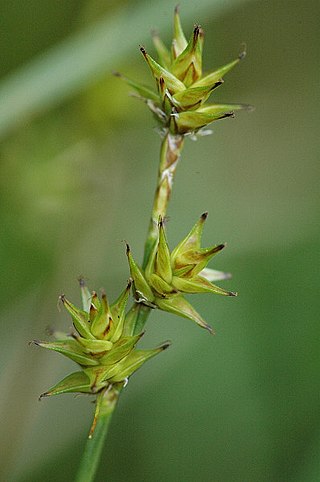
Carex echinata is a species of sedge known by the common names star sedge and little prickly sedge.

Lithops viridis is a species of plant in the family Aizoaceae.

Teucrium racemosum, also commonly referred to as either the grey germander or forest germander, is a species of flowering plant in the family Lamiaceae. It is endemic to Australia and is found in all mainland states, the Northern Territory and the Australian Capital Territory. It grows in floodplains, dry lake beds and open woodlands. A perennial herb, it has four-sided, densely hairy stems, narrow egg-shaped leaves, and white flowers usually arranged singly in leaf axils. It grows to be between 15 and 40 cm tall.
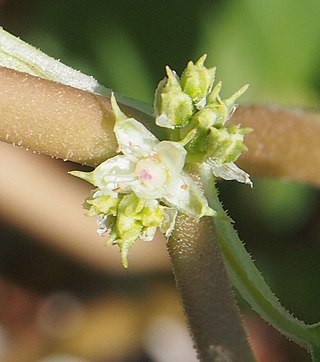
Tetragonia eremaea is a member of the genus Tetragonia and is endemic to Australia.
Tetragonia moorei is a member of the genus Tetragonia and is endemic to Australia.
Tetragonia nigrescens is a plant native to southern Africa.
Vlokia ater was the first species described for the genus Vlokia in the Aizoaceae plant family. The genus name honors the discoverer, South African botanist, Jan H. J. Vlok (1957-). The species name derives from the Latin adjective "ater" for "black" and refers to the black coloring which older leaf leaves assume.

Tetragonia fruticosa, or kinkelbossie, is an endemic Southern African coastal perennial shrub or scrambler, well-suited to dune sand stabilisation and often browsed by livestock and game. It is found from sea-level to about 1100 metres.
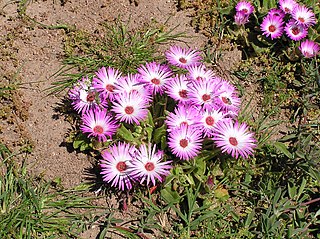
Dorotheantheae is a small tribe of annual succulents in the Aizoaceae subfamily Ruschioideae. Though it originally comprised three genera, Cleretum remains as the only recognised genus. Dorotheantheae are endemic to the western and south-western parts of South Africa. The type genus is Dorotheanthus, despite it being no longer recognised.
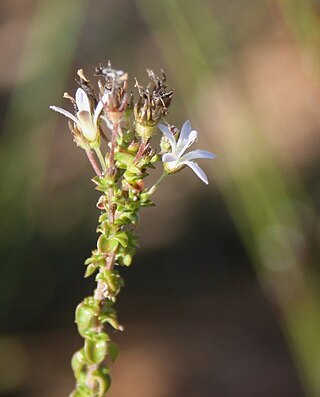
Wahlenbergia tenella is a herbaceous plant in the family Campanulaceae native to the southern Cape regions of South Africa.

Wahlenbergia loddigesii is a herbaceous plant in the family Campanulaceae native to the southern Cape regions of South Africa.

Wahlenbergia nodosa is a herbaceous plant in the family Campanulaceae native to the dry karoo regions of South Africa.
Tetragonia spicata is a Southern African perennial shrub or scrambler.
















